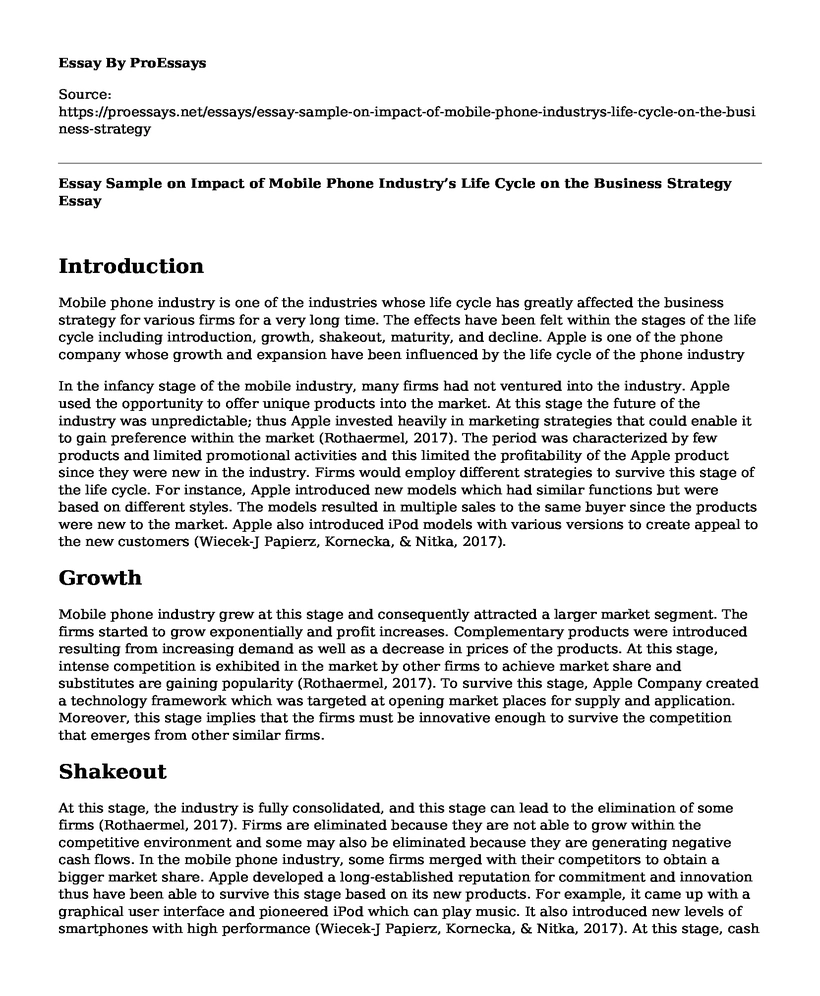Introduction
Mobile phone industry is one of the industries whose life cycle has greatly affected the business strategy for various firms for a very long time. The effects have been felt within the stages of the life cycle including introduction, growth, shakeout, maturity, and decline. Apple is one of the phone company whose growth and expansion have been influenced by the life cycle of the phone industry
In the infancy stage of the mobile industry, many firms had not ventured into the industry. Apple used the opportunity to offer unique products into the market. At this stage the future of the industry was unpredictable; thus Apple invested heavily in marketing strategies that could enable it to gain preference within the market (Rothaermel, 2017). The period was characterized by few products and limited promotional activities and this limited the profitability of the Apple product since they were new in the industry. Firms would employ different strategies to survive this stage of the life cycle. For instance, Apple introduced new models which had similar functions but were based on different styles. The models resulted in multiple sales to the same buyer since the products were new to the market. Apple also introduced iPod models with various versions to create appeal to the new customers (Wiecek-J Papierz, Kornecka, & Nitka, 2017).
Growth
Mobile phone industry grew at this stage and consequently attracted a larger market segment. The firms started to grow exponentially and profit increases. Complementary products were introduced resulting from increasing demand as well as a decrease in prices of the products. At this stage, intense competition is exhibited in the market by other firms to achieve market share and substitutes are gaining popularity (Rothaermel, 2017). To survive this stage, Apple Company created a technology framework which was targeted at opening market places for supply and application. Moreover, this stage implies that the firms must be innovative enough to survive the competition that emerges from other similar firms.
Shakeout
At this stage, the industry is fully consolidated, and this stage can lead to the elimination of some firms (Rothaermel, 2017). Firms are eliminated because they are not able to grow within the competitive environment and some may also be eliminated because they are generating negative cash flows. In the mobile phone industry, some firms merged with their competitors to obtain a bigger market share. Apple developed a long-established reputation for commitment and innovation thus have been able to survive this stage based on its new products. For example, it came up with a graphical user interface and pioneered iPod which can play music. It also introduced new levels of smartphones with high performance (Wiecek-J Papierz, Kornecka, & Nitka, 2017). At this stage, cash flows, profits, and growth of revenue move towards maturity.
Maturity
Well-established firms occupy the mobile phone industry in this stage because the industry has reached a saturation point. The firms attempt to protect themselves and sustain their competitive advantage. In an attempt to survive this stage, Apple Company developed innovative products that have a common operating system, applications, and software (Wiecek-J Papierz, Kornecka, & Nitka, 2017). This stage influences the firms to employ strategies that make them dominant to reduce competition. The stage, therefore, ensures monopoly within the industry.
Decline
This is the last stage of the industry cycle. The stage affects the firms within the industry as attributed to factors such as the level of exit barriers, the height of fixed costs, and speed of decline. It influences some firms to focus on the most preferred and profitable products. Some firms will also tend to absorb smaller firms and failing firms to boost their dominance. Apple as a firm within the mobile phone industry is equipped with a variety of suppliers, business partners, and developers; thus it exhibits a strong competitive advantage to survive this stage.
References
Rothaermel, F. T. (2017). Strategic management concepts (Custom 3rd ed.) New York, NY: McGraw-Hill.
Wiecek-Janka, E., Papierz, M., Kornecka, M., & Nitka, M. (2017). Apple products: A discussion of the product life cycle. In 4th International Conference on Management Science and Management Innovation (Vol. 31, pp. 159-164). Retrieved from https://www.researchgate.net/profile/Ewa_Wiecek-Janka/publication/319136921_Apple_products_A_discussion_of_the_product_life_cycle/links/599417d8458515c0ce64f927/Apple-products-A-discussion-of-the-product-life-cycle.pdf
Cite this page
Essay Sample on Impact of Mobile Phone Industry's Life Cycle on the Business Strategy. (2022, Dec 04). Retrieved from https://proessays.net/essays/essay-sample-on-impact-of-mobile-phone-industrys-life-cycle-on-the-business-strategy
If you are the original author of this essay and no longer wish to have it published on the ProEssays website, please click below to request its removal:
- Establishing a Price for a New Product Using the Law of Supply and Demand
- Essay on Should Children Carry Cell Phones to School?
- Microsoft: Competing on Talent Essay Example
- Essay Sample on Key Issues in Pharmaceutical Industry Supply Chains
- Palm Oil Demand and Supply: Navigating a Complicated Global Supply Chain - Essay Sample
- Challenges and Considerations in Cloud Computing Migration for 500-Fortune Organizations - Free Essay
- Essay Example: Impact and Importance of Migration in the Hotel Industry in Singapore







